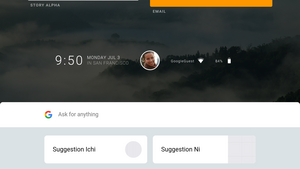 | |
 The Fuchsia GUI | |
| Developer | |
|---|---|
| Written in | Rust, C++, C, Dart, Go, Python, assembly language[2][3] |
| OS family | Capability-based[1] |
| Working state | Current |
| Source model | Open source |
| Initial release | May 25, 2021 |
| Latest release | F20[4] |
| Repository | |
| Available in | English |
| Platforms | ARM64, x86-64 |
| Kernel type | Microkernel |
| Influenced by | Pink, Android, Unix kernel (but not Unix-like), iOS |
| Default user interface | Ermine |
| License | BSD, MIT, Apache License 2.0 |
| Official website | fuchsia |
| Articles in the series | |
| Taligent | |
Fuchsia is an open-source capability-based operating system developed by Google. In contrast to Google's Linux-based operating systems such as ChromeOS and Android, Fuchsia is based on a custom kernel named Zircon. It publicly debuted as a self-hosted git repository in August 2016 without any official corporate announcement. After years of development, its official product launch was in 2021 on the first-generation Google Nest Hub, replacing its original Linux-based Cast OS.
- ^ "Language usage in Fuchsia". Noober Info. June 15, 2021. Archived from the original on August 24, 2022. Retrieved August 24, 2022.
- ^ "Google Fuchsia OS: The next big thing on the internet – Next-Gen OS". Fuchsia.
- ^ "C++ in Zircon". Fuchsia. Retrieved February 7, 2023.
- ^ https://fuchsia.dev/whats-new/release-notes/f20.
{{cite web}}: Missing or empty|title=(help)